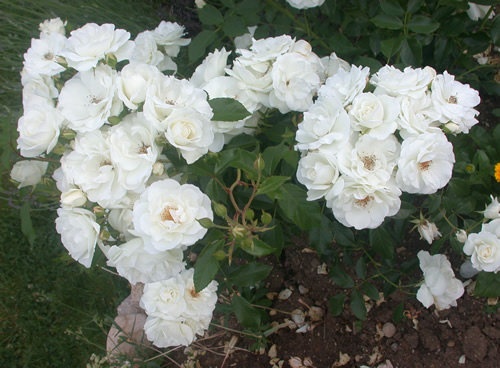
Iceberg photo courtesy of Mircir
Poor old Iceberg! Like the comedian Rodney Dangerfield, it "gets no respect!" It's planted by the tens of thousands, perhaps hundreds of thousands, all across California and the rest of the World. You'll see them crammed into every nook and cranny; in pots, beds and planters; as tree roses, bushes and climbers; in shopping centers, gas stations, private residences and public plantings.It's become so ubiquitous that even folks who know nothing about rose names, much less roses in general, know to ask for "Iceberg". The few who don't know that much, still ask for "that white rose you see everywhere." Many who know roses well, snub it as "over done".
This rose thrives where "traditional roses" fail. It will stand up to the standard "mow-blow-go" treatment, as well as "hack and slash" pruning, and refuse to die. I don't know of any other rose, as tolerant of such outright abuse and neglect, that's as willing to spring back for more. And, still look graceful and elegant while doing it!
One of the most wonderful of Iceberg's features, is its ability to "dance" with the breezes. Its slender canes are limber, but sturdy enough to proudly hold its clusters of flowers where they can be enjoyed. Let a breeze blow and watch them literally dance with the wind. I've seen "oceans" of its semi double, white clustered flowers waving in a gentle breeze. Massed, it's simply breathtaking!
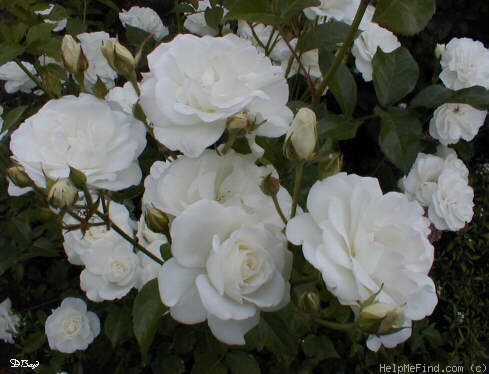
Iceberg photo courtesy of Dave and Deb Boyd
Iceberg is as shade tolerant as any other rose I can think of. Notice I said "tolerant". No rose grows as well in shade as it does sun. It's impossible to advise you as to how little sun, because that depends largely upon where in the World you live. As you approach The Equator, the intensity of sunlight increases dramatically. As you travel to higher latitudes, the light intensity decreases. If the plant can tolerate three or four hours of filtered sun in our climate here in Southern California, it may well require six or seven hours of similar light in Seattle, Washington. One thing is certain, Iceberg requires far less light to grow and explode into bloom than any other hybrid tea or floribunda.
Iceberg has been hailed as the World's best white floribunda, perhaps, the best floribunda, period. Sure, it's prone to mildew on the peduncles, but you may live with it, take steps to alleviate the problem using the fungicide of your choice, or decide not to grow it. It can also have problems with black spot, but a good deal of that can be helped simply by how you treat the rose. I'll explain more about this later.
Iceberg is such a good plant with so many desirable qualities, many rose breeders have used it in creating other wonderful roses. David Austin massaged its genes to create such beauties as Belle Story, Evelyn, Heritage, Glamis Castle and Perdita. It was even used to create a very dark red floribunda, appropriately called, Black Ice.
Climbing Iceberg is one of the more versatile climbing roses around. Its long canes are flexible and easily "trained". It will flower anytime other climbers can be expected to, and it will do it in far less light than many. Its flowers are large and attractive, and the light color shows well in reduced light. Climbing Iceberg wears the same dense, attractive foliage found on the other versions of Iceberg. Who could ask for more?
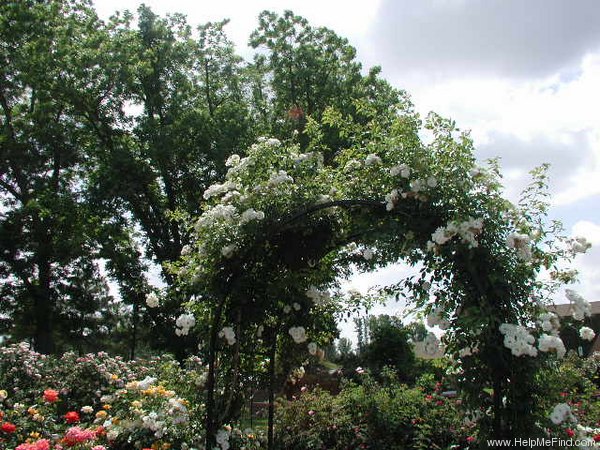
Climbing Iceberg photo courtesy of John & Robyn Sheldon
You'll encounter some Iceberg bushes which seem content to remain at the three to four foot height, while other "bush" versions demand to be allowed to develop into six or seven foot shrubs. And, these aren't even the extra vigorous mutation, "Climbing Iceberg"! These taller bushes can be effectively used as ever-blooming privacy screens, often impressing me as walls of snow.
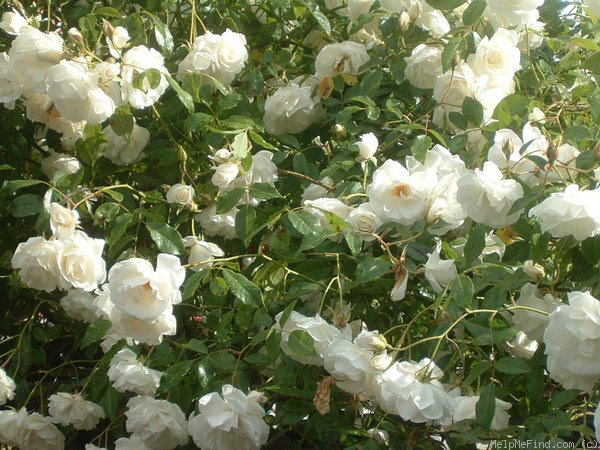
Climbing Iceberg photo courtesy of Chris Hunkeler
You'll also notice it can be extremely variable concerning the quantity and type of prickles each plant arms itself with. Most often, the more dwarf the plant, the fewer and smaller the prickles. As the genetically determined size of the plant increases, so do the quantity and size of the prickles. This actually is rather logical.
Roses, and most other plants, have a serendipitous ability to "sport", or mutate, altering one, few or even many characteristics when they do. It's common for a bush type to mutate to an extra vigorous type, usually referred to as its climbing sport. In order for a climbing rose to be successful in "the wild", it needs a method of attaching itself, at least temporarily, to some support, allowing it to "climb". More and larger prickles on these more vigorous sports enable them to hook themselves into a tree's bark, or on to one of its limbs for support while it continues to grow into and through the canopy and out into the sun.
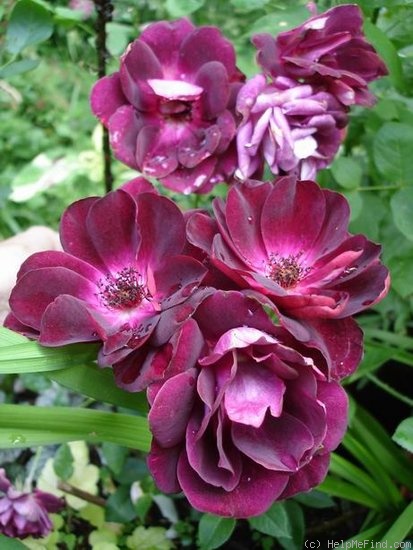
Burgundy Iceberg photo courtesy of Susanne Weber
Iceberg resulted from a cross between the red Hybrid Musk, Robin Hood, using the pollen from the white Hybrid Tea, Virgo. In harsher climates, Robin Hood is a small mound of a plant. Here in Southern California, it builds into a fairly large climber, much like other roses transplanted from more severe origins do when they encounter our "thirteen-month" growing season.
Robin Hood is descended from a line of polyantha crosses, originating from Crimson Rambler, a Hybrid Multiflora. The species, Multiflora, grows on the edges of woodlands. As small plants, they must be shade tolerant to survive until they can clamber up into and through the trees and out into the sun. Interestingly, Crimson Rambler and quite a few other Hybrid Multifloras are prone to mildew, and are also known for their shade tolerance.
There are other examples of roses descended from Multiflora, which exhibit this ability to express themselves as various sized plants. One of the most dramatic parallels is the polyantha, Mlle. Cecile Brunner. The original seedling began as a fairly continuous blooming bush, which can slowly build itself up to an 8' plant. In time, it mutated to Spray Cecile Brunner, an extra vigorous "bush" type. In mild climates, it can develop into an enormous mound of a plant. It even be used as a shorter climber, to say, 10' - 15'. The largest variant of Mlle. Cecile Brunner is the climbing form. This house eater can easily develop into a twenty-plus foot plant! Just as with Iceberg, the more dwarf plants have smaller and fewer prickles. The climbing forms are far more prickly.
While we may find it easier to consider these mutations as stable destinations, they're actually ranges on a continuum. A bush type of either rose can fall within a range of sizes and degrees of thorniness. That range can be from about a three-foot plant, to one twice or even three times the smaller size. Each bud used for propagation has the ability to express a different size or habit from the others on the same stem. No one actually knows why, it just is. This explains why you can find, in a field of the same Iceberg variant, dramatically varying plants, in both size and degree of prickles. The only variations to which a rose can mutate are the ones already contained within its set of genes. If the pedigree contains only red roses with no yellow ancestors, it can't mutate to a yellow flower. The genes to express the yellow pigments don't exist in the set of characteristics available for expression.
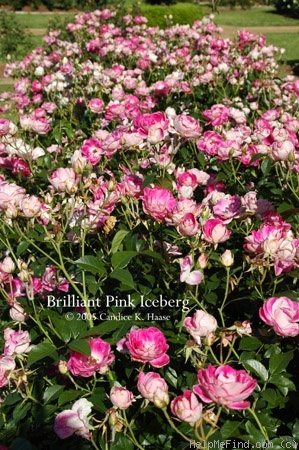
photo courtesy of Candice Haase
Back to how you treat an Iceberg can affect how likely it is to black spot… Most often, when I've encountered an Iceberg, which appears to be doomed to suffer from this fungus, it's been too harshly pruned. Modern, evergreen roses, store the energy needed to break dormancy and break into growth, in their canes. If a plant is programmed to be a five-foot by five-foot bush, and you repeatedly cut away large amounts of wood, hence its stored energy, to maintain a smaller size, you're likely to cause it to be malnourished. You not only deprive it of that stored food but, reduce the number of leaves it has to feed itself. It's a normal response in Nature for a stressed organism, whether the stress is due to malnourishment or other factors, to be more susceptible to diseases. "Starving" an Iceberg by keeping it cut too hard, can literally force it to black spot. I've frequently seen the same plant be allowed to grow larger and literally "out grow" the infection, even though the conditions favoring the disease hadn't materially changed.
Until recently, you could have this remarkable rose in any color you wanted, as long as it was white. A few years ago, a brilliant pink mutation was discovered and is now available. Depending upon how bright the light and how hot the temperatures, it can express hot pink to a near magenta, all beautifully "hand painted" on a white background. The pink flower color is another sport from the original white Iceberg, and can be expected to show variation just as the other characteristics can. A burgundy version is now available in the United States.
Over done? Perhaps, but isn't that like emulation, the most sincere form of flattery? Iceberg deserves respect. In many ways, it's probably the most perfect rose yet.